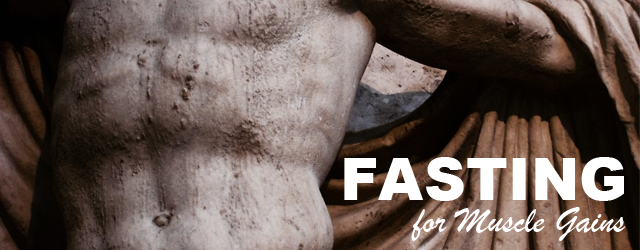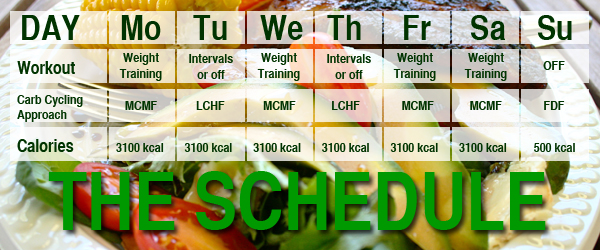
Header image photo by Thom Wall
It’s all a lie. I hear it in the gym, on television, and even on the streets. It doesn't make any sense to me. “If you want to pack on muscle, you need to eat every 2–3 hours.” Lies. The crazy thing is that I don't have any idea where this myth came from.
Back in the golden era of bodybuilding, legends such as Serge Nubret were eating only 1–2 meals per day. His logic was that tigers are lean and ripped and only eat 1–2 huge meals per day, so he did the same. Challenge accepted. Last year, I gained 30 lbs in eight months by only eating 1–2 meals per day. What I’m about to show you works. And it works really well.
This article is all about conquering the quest to gain lean muscle without the added fat. In order to accomplish this goal, we need to master two things—carb cycling with intermittent fasting and the optimization of your weekly caloric intake.
Carb Cycling with Intermittent Fasting
Carb cycling is easy. On days when you work out, eat more carbs. To take this one step further, we'll strategically skip eating in order to produce more growth hormone, detoxify the body, and aid digestion. For building lean mass, my recommendation is to have three different types of days—low carb high fat (LCHF), moderate carb moderate fat (MCMF), and a full-day fast (FDF). With this plan, assume that you will skip eating throughout every morning.
LCHF day: Save this eating style for non-workout days. Get all your calories from protein, fat, and non-starchy vegetables. Keep protein high with at least 1.2 grams per pound of lean body mass. Get all your calories via 1–2 huge meals in the afternoon and evening.
MCMF day: In contrast, this is your eating plan for non-workout days. Use an appropriate peri-workout nutrition protocol containing quick digesting carbs post-workout. All meals are to consist of protein, fat, and non-starchy vegetables with the exception of back loading carbs to an evening meal, which will consist of protein, starchy carbs, and non-starchy vegetables. Keep total protein high with at least 1.2 grams per pound of lean body mass. Again, all your calories should be eaten in 1–2 huge meals in the afternoon and evening and in your peri-workout nutrition.
FDF: Once per week, you will fast throughout the day until two hours before you go to bed. At this time, eat a small meal consisting of 30–50 grams of protein, some fat, and a ton of non-starchy vegetables. Use a weekly FDF to detoxify the body, aid digestion, and increase growth hormone. Remember, better digestion means more muscle and less fat.
The purpose of this carb cycling approach is to strategically burn fat and build muscle at different times throughout the day and week. At periods when you're fasting or not eating carbs, your insulin levels are kept low and your body is mobilizing fat for energy. We will spike insulin via peri-workout nutrition post-workout to build and repair muscle.
But Jason, why are the carbs so low? In order to build lean mass, you don’t necessarily need a huge amount of carbs. All you need is enough carbs post-workout to prevent catabolism as well as some in the evening to replenish glycogen in the muscles. As long as you're eating in a caloric surplus and training hard, you will build muscle—with or without the extra carbohydrates.
Weekly Caloric Intake
Calories in versus calories out, right bro? Yes. Most people reading this article already have a decent understanding of good food choices. You already know that real food is better than processed food and that if you’re hitting your macros from 80–90 percent real food, you’ll look pretty awesome. With that basic knowledge, it ends up coming down to calories in versus calories out. You want to pack on slabs of lean, athletic muscle, right? Then you need to eat more than you burn. End of story.
Here’s where things may shock you. You don’t need to eat nearly as much as you think in order to pack on muscle. It seems like the majority of information out there is for beginners or 'hard gainers' who want to gain muscle. I have no idea why, but everyone thinks that he's a 'hard gainer.' Here’s the easy way to know. If you aren't a skinny weakling and have managed to put on at least 20 lbs of muscle in your first two years of lifting and you look pretty decent, you aren't a hard gainer. This isn’t saying much, but it’s good progress for a hard gainer. If this is the case, you aren't even a beginner anymore. This means that you don’t need to eat nearly as much food as you think in order to gain muscle but stay lean.
To start off, you will need to figure out what your daily maintenance caloric intake is. An easy way to calculate this is to multiply your lean body mass by 16 kcal if you're under 15 percent body fat. Otherwise, multiply your lean body mass by 14 kcal. As an example, let’s use a 185-lb male with 13.5 percent body fat. This means he would need to eat approximately 2500 kcal per day in order to maintain his physique.
Let’s take a closer look. In order to gain lean mass, I recommend an extra 200 kcal above maintenance per day (on average). This would mean that this 185-lb male needs to average 2700 kcal per day. Multiplying this by seven gives 18,900 kcal per week. This is your weekly caloric intake.
Because you aren't eating the same amount of calories per day (thanks to the FDF), your weekly caloric intake has priority over your daily caloric intake. Let’s assume you eat a small meal on your FDF consisting of three eggs, four pieces of bacon, and a side salad (sans dressing). This equals approximately 500 kcal. Subtracting that from your weekly caloric intake leaves you with 18,400 kcal to spare. Dividing that by the remaining six days in the week will give you approximately 3100 kcal per day. Knowing your target for the day, you can eat all your food in 1–2 meals. If you have trouble eating large amounts of food, try eating a quarter cup of sauerkraut before you dig in. It’ll massively aid your digestion. Serge Nubret was known to eat 0.75 kg of horse meat in one sitting. I don’t know about you, but this sounds amazing to me.
Fasting for Muscle Gain Weekly Schedule
Using our 185-lb male, I’ve constructed a sample weekly schedule. Obviously, this eating program is meant to be used in conjunction with a muscle building weight training program. Any program on this website is more than sufficient. In the following schedule, I will use a four-day per week lifting schedule as an example.
As you can see, you will only be ingesting carbs if you have weight trained that day. You will be overeating six days per week. Likewise, you will undereat once a week.
Eat Like a Tiger
There you have it, my friends. I’ve given you a few simple methods to use intermittent fasting in order to build lean mass:
- Eat 1–2 meals per day.
- Cycle your carbs and get at least 1.2 grams of protein per pound of lean body mass.
- Drastically undereat once per week to detoxify the body, increase growth hormone, and aid digestion.
- Abide to your weekly caloric intake.
Embrace Serge Nubret’s inspiration to eat like a tiger, and you will build lean, athletic muscle to help you attract a hot cat.










Amazingly covered this very popular and controversial topic. I honestly gained a lot of insights on fasting during muscle gain and will definitely apply it to my diet regimen someday.